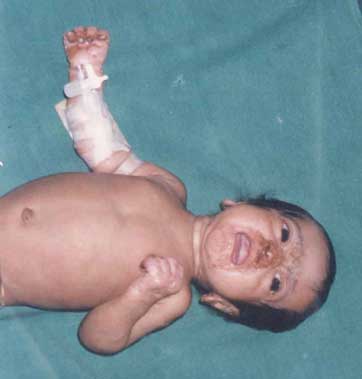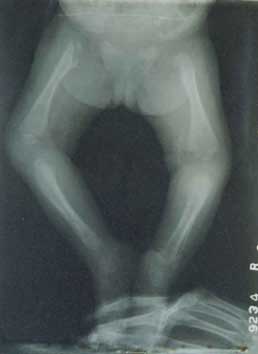A term SGA baby boy with
failure to thrive presented at two and a half months of age with skin
lesions of 2 weeks duration and diarrhea for one week. On examination,
the baby had copious rhinitis with excoriation and crusted lesions
around the nasal vestibule (Fig. 1). He also had erythematous
lesions with desquamation on the palms, soles, perianal and scrotal
regions. The baby was irritable but there was no evidence of
pseudoparalysis. The hair and nails were normal. There was no
hepatosplenomegaly. Rest of clinical examination was normal. Both mother
and father did not give any history of genital lesions, and their
clinical examination was normal.

Fig. 1. Crusted lesions
around the nose and erythematous desquamation on palms, soles and
perianal and scrotal region.
Differential diagnoses of
congenital syphilis and acrodermatitis enteropathica were considered at
admission. Skeletal survey showed mataphysitis and osteochondritis of
both proximal femora, more pronounced on the left side; and periostitis
of long bones (Fig. 2). Serum VDRL was reactive in 1:4 dilutions
in the baby, mother and, father, but TPHA was positive in all of them.
The baby was treated with intravenous aqueous penicillin G in a dose of
1,00,000 units/kg/day for 14 days. The lesions healed and he became
asymptomatic in 2-3 weeks. Both parents were given three doses of 2.4 MU
of Benzathine penicillin.

Fig. 2. Osteochondritis and metaphysitis
of femora and periostitis of tibia and femur.
Syphilis during pregnancy
has a transmission rate approaching 100%. "Snuffles"- the
characteristic mucopurulent or bloody copious rhinitis - is an early and
distinctive manifestation of congenital syphilis. Mucocutaneous rash,
osteochon-dritis, and periostitis which this infant had are commonly
seen. Acrodermatitis enteropathica also presents with failure to thrive,
similar type of skin lesions and diarrhea. But in addition they also
have a peculiar reddish tinted hair, alopecia and ocular manifestations,
which this baby didnít have. Bone lesions are also not seen in
acrodermatitis enteropathica.
